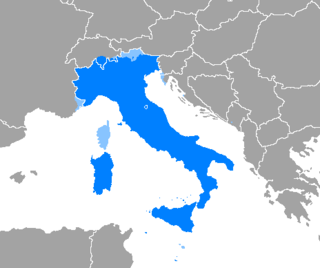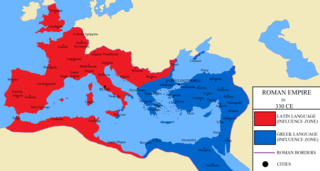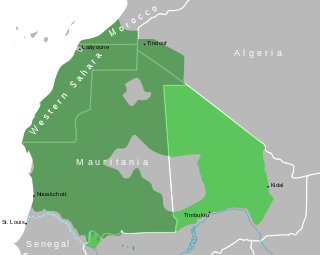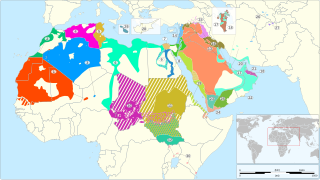
Arabic is a Central Semitic language of the Afroasiatic language family spoken primarily in the Arab world. The ISO assigns language codes to 32 varieties of Arabic, including its standard form of Literary Arabic, known as Modern Standard Arabic, which is derived from Classical Arabic. This distinction exists primarily among Western linguists; Arabic speakers themselves generally do not distinguish between Modern Standard Arabic and Classical Arabic, but rather refer to both as al-ʿarabiyyatu l-fuṣḥā or simply al-fuṣḥā (اَلْفُصْحَىٰ).
In linguistics, declension is the changing of the form of a word, generally to express its syntactic function in the sentence, by way of some inflection. Declensions may apply to nouns, pronouns, adjectives, adverbs, and determiners to indicate number, case, gender, and a number of other grammatical categories. Meanwhile, the inflectional change of verbs is called conjugation.

Italian is a Romance language of the Indo-European language family that evolved from the Vulgar Latin of the Roman Empire. Italian is the least divergent Romance language from Latin, together with Sardinian. Spoken by about 85 million people including 67 million native speakers (2024), Italian is an official language in Italy, San Marino, and Switzerland, and is the primary language of Vatican City. It has official minority status in Croatia and in some areas of Slovenian Istria.

The Indo-European languages are a language family native to the overwhelming majority of Europe, the Iranian plateau, and the northern Indian subcontinent. Some European languages of this family—English, French, Portuguese, Russian, Dutch, and Spanish—have expanded through colonialism in the modern period and are now spoken across several continents. The Indo-European family is divided into several branches or sub-families, of which there are eight groups with languages still alive today: Albanian, Armenian, Balto-Slavic, Celtic, Germanic, Hellenic, Indo-Iranian, and Italic; another nine subdivisions are now extinct.

The Romance languages, also known as the Latin or Neo-Latin languages, are the languages that are directly descended from Vulgar Latin. They are the only extant subgroup of the Italic branch of the Indo-European language family.

The Uralic languages form a language family of 42 languages spoken predominantly in Europe and North Asia. The Uralic languages with the most native speakers are Hungarian, Finnish, and Estonian. Other languages with speakers above 100,000 are Erzya, Moksha, Mari, Udmurt and Komi spoken in the European parts of the Russian Federation. Still smaller minority languages are Sámi languages of the northern Fennoscandia; other members of the Finnic languages, ranging from Livonian in northern Latvia to Karelian in northwesternmost Russia; and the Samoyedic languages, Mansi and Khanty spoken in Western Siberia.

Vulgar Latin, also known as Popular or Colloquial Latin, is the range of non-formal registers of Latin spoken from the Late Roman Republic onward. Vulgar Latin as a term is both controversial and imprecise. Spoken Latin existed for a long time and in many places. Scholars have differed in opinion as to the extent of the differences, and whether Vulgar Latin was in some sense a different language. This was developed as a theory in the nineteenth century by Raynouard. At its extreme, the theory suggested that the written register formed an elite language distinct from common speech, but this is now rejected.
Fusional languages or inflected languages are a type of synthetic language, distinguished from agglutinative languages by their tendency to use single inflectional morphemes to denote multiple grammatical, syntactic, or semantic features.
A dialect continuum or dialect chain is a series of language varieties spoken across some geographical area such that neighboring varieties are mutually intelligible, but the differences accumulate over distance so that widely separated varieties may not be. This is a typical occurrence with widely spread languages and language families around the world, when these languages did not spread recently. Some prominent examples include the Indo-Aryan languages across large parts of India, varieties of Arabic across north Africa and southwest Asia, the Turkic languages, the Chinese languages or dialects, and parts of the Romance, Germanic and Slavic families in Europe. Terms used in older literature include dialect area and L-complex.

Classical Arabic or Quranic Arabic is the standardized literary form of Arabic used from the 7th century and throughout the Middle Ages, most notably in Umayyad and Abbasid literary texts such as poetry, elevated prose and oratory, and is also the liturgical language of Islam. Classical Arabic is, furthermore, the register of the Arabic language on which Modern Standard Arabic is based.

Hassaniya Arabic is a variety of Maghrebi Arabic spoken by Mauritanian Arabs and the Sahrawi people. It was spoken by the Beni Ḥassān Bedouin tribes of Yemeni origin who extended their authority over most of Mauritania and Morocco's southeastern and Western Sahara between the 15th and 17th centuries. Hassaniya Arabic was the language spoken in the pre-modern region around Chinguetti.

In linguistics, mutual intelligibility is a relationship between languages or dialects in which speakers of different but related varieties can readily understand each other without prior familiarity or special effort. It is sometimes used as an important criterion for distinguishing languages from dialects, although sociolinguistic factors are often also used.

Linguistic purism or linguistic protectionism is the prescriptive practice of defining or recognizing one variety of a language as being purer or of intrinsically higher quality than other varieties. Linguistic purism was institutionalized through language academies, and their decisions often have the force of law.
The Neo-Aramaic or Modern Aramaic languages are varieties of Aramaic that evolved during the late medieval and early modern periods, and continue to the present day as vernacular (spoken) languages of modern Aramaic-speaking communities. Within the field of Aramaic studies, classification of Neo-Aramaic languages has been a subject of particular interest among scholars, who proposed several divisions, into two, three or four primary groups.

The internal classification of the Romance languages is a complex and sometimes controversial topic which may not have one single answer. Several classifications have been proposed, based on different criteria.

Uralic–Yukaghir, also known as Uralo-Yukaghir, is a proposed language family composed of Uralic and Yukaghir.
African Romance or African Latin is an extinct Romance language that was spoken in the various provinces of Roman Africa by the African Romans under the later Roman Empire and its various post-Roman successor states in the region, including the Vandal Kingdom, the Byzantine-administered Exarchate of Africa and the Berber Mauro-Roman Kingdom. African Romance is poorly attested as it was mainly a spoken, vernacular language. There is little doubt, however, that by the early 3rd century AD, some native provincial variety of Latin was fully established in Africa.

Arabic is the official language of Syria and is the most widely spoken language in the country. Several modern Arabic dialects are used in everyday life, most notably Levantine in the west and Mesopotamian in the northeast.

In linguistic morphology, inflection is a process of word formation in which a word is modified to express different grammatical categories such as tense, case, voice, aspect, person, number, gender, mood, animacy, and definiteness. The inflection of verbs is called conjugation, and one can refer to the inflection of nouns, adjectives, adverbs, pronouns, determiners, participles, prepositions and postpositions, numerals, articles, etc., as declension.

Varieties of Arabic are the linguistic systems that Arabic speakers speak natively. Arabic is a Semitic language within the Afroasiatic family that originated in the Arabian Peninsula. There are considerable variations from region to region, with degrees of mutual intelligibility that are often related to geographical distance and some that are mutually unintelligible. Many aspects of the variability attested to in these modern variants can be found in the ancient Arabic dialects in the peninsula. Likewise, many of the features that characterize the various modern variants can be attributed to the original settler dialects as well as local native languages and dialects. Some organizations, such as SIL International, consider these approximately 30 different varieties to be separate languages, while others, such as the Library of Congress, consider them all to be dialects of Arabic.














